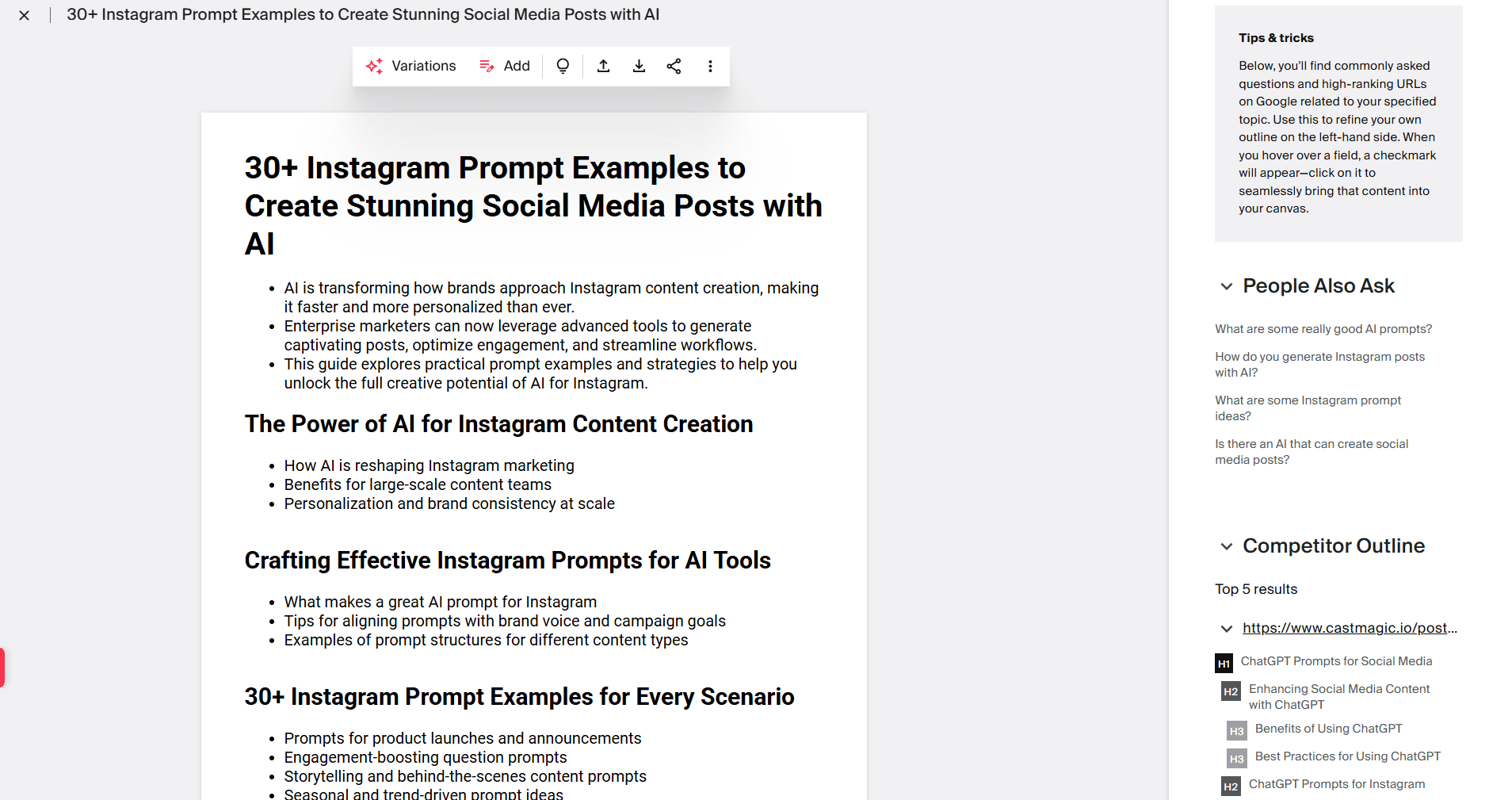AI at Work
Creating Content for AI Assistants: Optimizing for Voice and Conversational Search

Akshita Sharma · Content Marketing Associate
October 9th, 2025 · 15 min read

Every day, millions of people use search to ask for recommendations, seek solutions, and make decisions. But the way people do that has evolved. They aren't typing "pizza restaurant NYC" anymore. Instead, they're asking their phones questions like, "Where can I get the best pizza delivered tonight?"
With more than 8.4 billion voice assistants in use today, voice search represents the biggest shift in content discovery since Google's early days.
And yet, most marketing teams are approaching it using traditional SEO techniques.
AI assistants think differently. They evaluate content differently. They present results differently than search engines ever did. As a result, voice search optimization now requires content that sounds natural when read aloud, answers complete questions rather than keyword fragments, and anticipates the natural follow-ups that people ask.
In this blog, we'll cover all this and more.

What is voice search optimization?
Voice search optimization is the process of creating content that shows up when people ask questions out loud instead of typing them into a search bar. (Hint: People speak differently than they type.)
When typing, someone might search "weather forecast NYC."
When speaking, they ask, "What's the weather going to be like in New York City tomorrow?"
The same seems to be true of how users engage with LLMs and chat bots.
This requires a complete reimagining of your content strategy. You need to optimize content for featured snippets, structure information to answer complete questions, and create content in natural language that voice assistants can easily parse and present as spoken responses.
How is voice search different from traditional search?
While traditional search relies on keywords, voice search tends to be more conversational. People speak in complete sentences and ask real questions. As a result, voice search queries are typically longer, packed with context clues and semantic relationships that reveal genuine intent.
But the biggest difference between traditional search and voice search is that voice search happens everywhere, all the time.
The integration of AI-powered voice assistants across multiple devices has created an ecosystem where your smart speaker catches your morning question about traffic. Your phone answers queries while you're cooking. The voice assistant in your car finds that restaurant you mentioned. Unlike traditional search, which requires you to stop, open a browser, and type, voice search seamlessly weaves into your daily routine.
What’s more, today's voice assistants handle complex, multi-part questions that would have required multiple Google searches just a few years ago. They understand context, remember what you asked five minutes ago, and increasingly anticipate what you need before you ask.
This transforms voice search from a simple input method into an intelligent interface that bridges the gap between human communication and digital functionality.
User expectations have also evolved accordingly. People now expect immediate, complete answers, especially for local and time-sensitive queries. "Is the pharmacy still open?" should yield a direct yes or no, not a list of ten blue links to sort through.
For businesses, this means rethinking search optimization. Traditional SEO targeted keywords, but voice search demands understanding how people naturally speak and structuring content to answer complete questions. You need to optimize for featured snippets, claim your local listings, and anticipate user queries.
The conversational nature of voice search also points toward a future where search becomes increasingly interactive and contextual. Rather than simple question-and-answer exchanges, we're moving toward sustained conversations with voice assistants that understand context, remember preferences, and provide personalized experiences across multiple touchpoints.
The convergence of voice search and AI
Voice search in 2025 has evolved beyond just search. It's blending with AI so quickly that "voice search" doesn't entirely capture what's happening anymore.
Powered by generative AI, today's search experiences are more conversational, multimodal, and assistive than ever before. Instead of a step-by-step funnel, the search journey has become an adaptive path shaped by voice, chat, image, and context.
The merger of voice search and AI points towards more natural, intuitive human interaction with technology. For content creators and marketers, this presents both challenges and opportunities. Those who adapt their content strategies to this new conversational, multimodal reality will find themselves well-positioned in an increasingly voice-first world.
How to create content for AI voice assistants?
Voice search optimization requires a change in how you craft content, because again, real people don't speak in keyword fragments. They ask complete questions with context, emotion, and intent. The trick is thinking through the actual conversations your audience has with their voice assistants.
Here are some voice search optimization strategies to create content that AI assistants turn to when people ask questions in your domain:
1. Use intent-driven, long-tail keywords
Voice queries typically run longer (averaging 29 words) than typed searches. When you're optimizing content for conversational search, make sure it mirrors the way people naturally ask questions.
While short-tail keywords are highly competitive, long-tail keywords allow businesses to rank for niche searches more easily. Start with the long-tail keywords that drive most voice searches: how, what, where, when, and why.
Worth Noting
Worth Noting
Nearly 20% of all voice search queries are triggered by a set of 25 keywords, consisting mainly of question words like "how" or "what" and adjectives like "best" or "easy".
But don't stop there. Dig into the specific problems your audience faces and address related issues that might arise from the initial query.
Tools like AnswerThePublic and Google's "People Also Ask" can become your research companions here. They can reveal the exact language your audience uses, complete with their hesitations, specifications, and real-world constraints.
If you're using Typeface, the Web Agent streamlines this process by providing smart research assistance directly within your workflow. It automatically surfaces relevant questions from Google's "People Also Ask" (PAA) section and pulls content outlines from high-ranking URLs related to your topic. You can quickly review these suggestions to understand what queries your target audience is asking and identify content gaps you can fill.

By crafting content using relevant long-tail keywords, you create content that meets the evolving needs of your audience and improve your chances of being featured in voice search results.
2. Build your content around real questions
We've talked about using keywords that mirror the way people ask questions. Now let's take that insight deeper into your content structure itself.
When crafting your content, think of it as having a conversation with your audience. Because that's exactly what voice search optimization is. It's about creating content that genuinely serves people who speak their queries aloud.
Start each section with a question, then deliver a direct, conversational response. This format mirrors how people naturally seek information and aligns perfectly with how voice assistants parse and present content.
Consider adding FAQ sections at the end of your content, using real customer inquiries from support tickets, social media exchanges, and sales discussions to ensure authenticity.
Google Search Console can also help pinpoint long-tail queries that are already bringing visitors to your site, allowing you to craft specific FAQ entries for these questions.
Google Search Console remains valuable for identifying long-tail queries that bring visitors to your site, though you'll need to interpret recent data with some caution.
Recently, Google removed the num=100 parameter that previously allowed viewing 100 search results per page. This has created noticeable disruptions in how performance metrics appear. Recent analysis of over 300 websites shows that 87.7% saw drops in Search Console impressions, while 77.6% lost visibility on unique ranking terms.
The silver lining is that the data you're now seeing on Google Search Console may be more accurate, as the previous influx of impressions from scrapers using the parameter has been eliminated.
This means the questions and queries showing in your Search Console data likely represent genuine user interest, making them even more valuable for crafting FAQ entries that address real search intent.
3. Create scannable hierarchies that AI assistants love
When someone asks their voice assistant about your topic, the algorithm needs to quickly identify which section contains the answer. A well-structured H1, H2, H3 hierarchy creates clear pathways for this extraction process, improving your chances of being selected for voice results.
Your H1 should mirror the primary question your audience asks, not a clever brand tagline. This isn't about sacrificing creativity; it's about speaking the same language as your audience when they're talking to their devices.
H2 tags become your content's chapter markers, organizing major sections that address different aspects of the main question. For voice search, these work especially well when they mirror the "People Also Ask" suggestions you find in Google search results. If your main topic triggers PAA boxes, structure your H2s to directly answer those related questions.
H3s provide the supporting detail that voice assistants need for comprehensive responses. But they should be conversational. For example: instead of "Technical Specifications," use "What features should I look for?" This natural language approach helps voice assistants match your content with the way people actually phrase their queries.
Bottom line: if someone scanned only your headings, would they understand your content's main ideas? If not, restructure them. Voice assistants essentially do this same scanning process, but at machine speed, deciding in milliseconds whether your content deserves to surface as an answer to a voice search query.
4. Deliver concise, scannable responses
Voice assistants favor content that gets to the point fast because when someone asks their device a question, they expect an immediate, complete response.
The structure of your content becomes critical here. To create concise, scannable content, here are some things to keep in mind:
Use short paragraphs (2-3 sentences maximum), bullet points, and numbered lists because search engines can easily parse and extract these formatted elements
Front-load your most crucial information within the first sentence or two of each answer.
Remove every unnecessary word. Voice search optimization demands that you eliminate filler phrases, redundant explanations, and corporate jargon that adds no value. If a sentence doesn't directly answer the user's question or provide actionable information, cut it.
Voice assistants reward content that respects users' time by delivering exactly what they asked for, nothing more.
5. Create strategic content clusters
While your previous four tactics focus on individual pages, voice search thrives on comprehensive topic coverage.
When someone asks, "What's the best small business marketing strategy?", they're starting a conversation that might lead to questions about social media, email campaigns, local advertising, or budget allocation.
This is where creating topic clusters can prove to be incredibly useful. Search engines are going to evaluate your expertise across interconnected content rather than isolated pages (see AI Overviews and fan-out queries, for example). Voice assistants follow the same logic. They draw answers from sites that demonstrate comprehensive knowledge around central themes.
To build content clusters, create a comprehensive pillar page that covers your core topic broadly. Then build supporting pages that dive deep into specific subtopics. Each cluster page should link back to the pillar and to related cluster content, creating a semantic web that search engines can easily navigate and understand.
Beyond SEO benefits, creating topic clusters solves a fundamental user experience challenge: they transform your website from a collection of random pages into a cohesive knowledge resource.
This comprehensive approach signals to search engines (and to voice assistants selecting answers) that you're not just creating content, you're building authority around topics that matter to your audience.
6. Connect the dots with internal linking
While topic clusters create the foundation, internal linking transforms isolated pages into an interconnected knowledge network that both users and AI assistants can navigate seamlessly.
When internal linking is done strategically within a cluster, it creates a clear path for search engine bots to follow. A pillar page acts as the entry point, and its links to cluster pages ensure that all related content is indexed efficiently and understood contextually.
The hub-and-spoke model requires systematic execution. Every cluster page should link back to the main pillar page, and when cluster topics overlap or complement each other, they should be interconnected as well.
Consider the natural information-seeking behavior that voice search encourages. Users often ask follow-up questions during the same session, expecting related information without starting over. Your internal linking structure should support this behavior, making it easy for both users and AI systems to discover additional relevant content that extends the conversation.
7. Strengthen technical foundations
Voice search success also requires a solid technical infrastructure.
Mobile-first optimization is non-negotiable since most voice searches happen on smartphones. Fast loading pages can significantly improve your chances of being selected for voice responses. Compress images, minimize JavaScript, and leverage browser caching to achieve sub-3-second load times.
Schema markup, particularly FAQ schema, helps search engines understand your content structure and surface your content. When you mark up your FAQ sections with structured data, you're essentially giving AI assistants a roadmap to your most valuable answers.
Local optimization becomes critical for location-based queries. Ensure your Google Business Profile is accurate and complete and naturally incorporate local keywords into your content.
Empower your brand for the future of voice search
As voice assistants become the go-to gateway for information, your brand's ability to show up in these conversations will define your relevance. Voice search optimization isn't just another SEO tactic to check off your list. It's about meeting your audience where they already are, with genuinely helpful content that answers real questions.
Ready to make your brand voice-search ready? Typeface can empower your brand to create personalized content that drives in the era of AI assistants. Book a demo today to learn how we can deliver a customized solution tailored to your organizations needs.
Frequently Asked Questions
Q. Does voice search use AI?
Absolutely. What makes modern voice search powerful is that it uses AI that understands context, intent, and even tone, not just individual words. When someone says, "Find me a good place for dinner nearby," the AI recognizes they want restaurant recommendations in the area. These systems personalize results based on location and preferences. This means that if you often order vegetarian meals, your assistant might recommend vegetarian-friendly restaurants first.
Q. How does voice search affect SEO?
Voice search creates a winner-takes-all dynamic that fundamentally changes SEO strategy. Over 80% of voice search answers come from the top three organic results, which means you're no longer competing for page-one visibility but for podium placement. It also demands a complete rethinking of keyword strategy. Voice queries average 29 words compared to 3-4 words for text searches, so your content needs to target full conversational phrases, not fragmented keywords.
Q. What is the difference between voice search and traditional text search?
Voice search involves speaking queries naturally to AI assistants, which typically results in longer, conversational phrases. Traditional text search, on the other hand, uses shorter key phrases. Voice queries are also three times more likely to have local intent, meaning users expect immediate, location-specific answers. The results differ too: voice assistants typically read a single answer from featured snippets, whereas text search displays multiple options for users to browse.
Q. Do I need different content for voice search versus regular SEO?
You don't need entirely different content, but you need to optimize existing content for conversational queries. The same foundational content can serve both purposes when you optimize for conversational queries. Add question-based headings (H2/H3) that match how people actually speak, include FAQ sections with direct answers, and weave in long-tail keywords that reflect natural speech patterns.
The key is making your existing content more conversational and answer-focused without diluting the depth that traditional SEO values.
Q. How do you adapt existing content for conversational search?
Start by reviewing your current content to identify your highest-performing pages. Once you’ve selected the content you want to optimize, perform the following optimizations:
Add question-based H2/H3 headings that mirror voice queries
Rewrite key sections to sound conversational but authoritative
Place direct answers of 40-50 words immediately after question headings, then expand with supporting details
Add structured data markup (FAQ schema or HowTo schema) to help search engines understand your content format
Transform bullet points into numbered lists for step-by-step processes

Share
Related articles

AI at Work
AI Content Strategy 101: Why Early Outputs Fall Short and How to Fix Them

Elah Horwitz · Customer Success Manager
July 31st, 2025 · 12 min read

AI at Work
How to Use AI Writing Assistants for Better Long-Form Content Creation

Bryan Kitch · Senior Content Marketing Manager
November 26th, 2025 · 12 min read

AI at Work
AI Agents in Marketing: Orchestrating Autonomous Marketing Tasks

Neelam Goswami · Content Marketing Associate
June 27th, 2025 · 13 min read